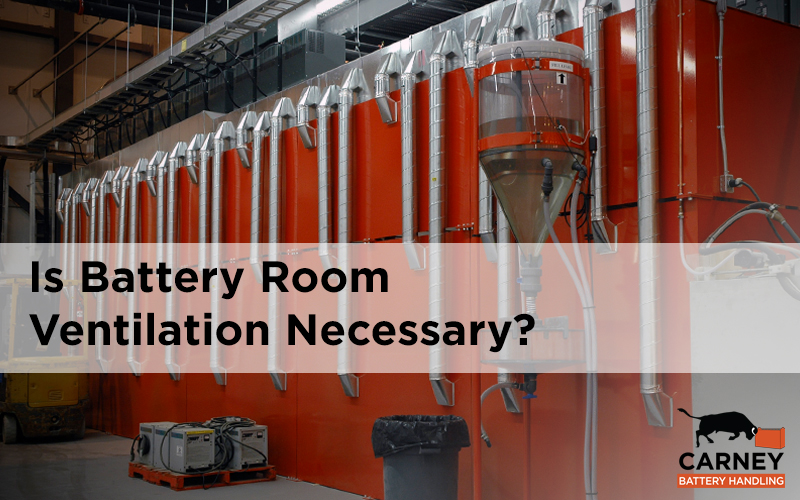The short answer is yes. However, to what extent its necessary depends entirely on the location and the local environment. For example, if you are only charging one truck/battery you may not require ventilation or if your battery room is located in a very warm country like Mexico and you decide to have your battery charging area outside with just a roof over it, then you certainly don’t require ventilation as it is already open to the environment. However, most battery rooms are located inside a building and this is when proper ventilation becomes very important.
Simply put, there are two main gasses that are produced when a lead acid battery is being charged. One is hydrogen gas which is colourless, odorless, and 14x lighter than air, allowing it to immediately travel to the ceiling. The other is hydrogen sulfide, which typically has a rotten egg smell. This gas is heavy and rolls off the top of the battery as it’s heavier than air traveling to wherever there is negative air pressure in the building. If your batteries are not watered regularly and one cell starts to burn up from charging, then the amount of hydrogen sulfide gas produced can be extremely high.
The biggest concern we see in battery charging areas is the accumulation of hydrogen gas that is produced during the charging cycle. If this gas reaches a point where the mixture is approximately 1-2%, then it becomes extremely explosive and can be set off by the smallest spark. The hydrogen sulfide gas is usually not as great of a health hazard but can be obnoxious and cause employee complaints. Both of these gases should be addressed in battery charging areas.
There are at least three different choices for a battery charging room design in a building, and each one has unique requirements.
If your building is a freezer or the entire building is extremely hot due to your manufacturing processes, then you will certainly want to consider a fully closed-in charging room and this will require special consideration for ventilation. The smaller the area, the more concentration of hydrogen.
Another option is to install the battery charging area in the center of the plant or distribution center and have it completely open, but with safety fencing. This seems to be the most common option.
The last option is a combination of the two where the charging room is located in a corner or near the loading dock area and is partially closed-in.
Closed-in rooms are the easiest to ventilate because usually the rooms are small, self-contained areas and there are no cross drafts to contend with. Common practice is to ventilate at the highest point of the ceiling to eliminate the hydrogen gas and to also ventilate at the lowest point of the floor to pick up any of the heavy sulfide gasses. In this type of application, it is always prudent to install a hydrogen detector on the ceiling for added safety. Most companies install a hydrogen detector in an enclosed battery room and these units can send alarm signals or turn on ventilation fans when the hydrogen gas concentration get too high.
When battery charging rooms are located in the center of the building, it becomes a bigger challenge. Any cross drafts or exhaust fans in the adjacent area will dissipate these gasses or shift them to other areas making it hard to contain them and, in most situations, it is not practical or too expensive to exhaust the entire plant. However, there is a solution for this problem. Carney Battery Handling has developed a charging rack system that is fully closed-in on three sides leaving only the front open. When an exhaust fan and duct work are connected to it, this charging rack system immediately becomes a fume hood that captures up to 95% of all gasses from the battery during the charging process. There are also other benefits when using a fume hood. As the air is extracted across the top of the battery, it helps to cool the batteries as they are charging and most important, because the charging racks are closed-in, the amount of exhaust air required is minimal. Pumping cold air out in the summer or warm air out in the winter can be expensive.
This same type of exhaust system also works very well when the charging room is partially closed-in.
Our 35 years of experience has confirmed that simple overhead fume hoods that are not fully enclosed may look good, but they do not work very well.
The regulations for battery room ventilation vary greatly between countries. They also fall under numerous different governing authorities from Federal to state, provincial and even local authorities. It is extremely important to ensure that you comply with all governing bodies when installing ventilation in your battery charging area.
For more information or help with your ventilation requirements, just give us a call or email sales@carneybatteryhandling.com.
To learn more about our Ventilation Systems, click here.
ABOUT THE AUTHOR
Wayne Carney is the Founder and CEO of Carney Battery Handling Ltd.

